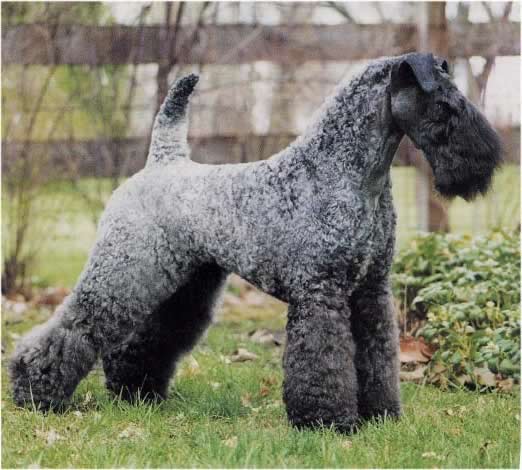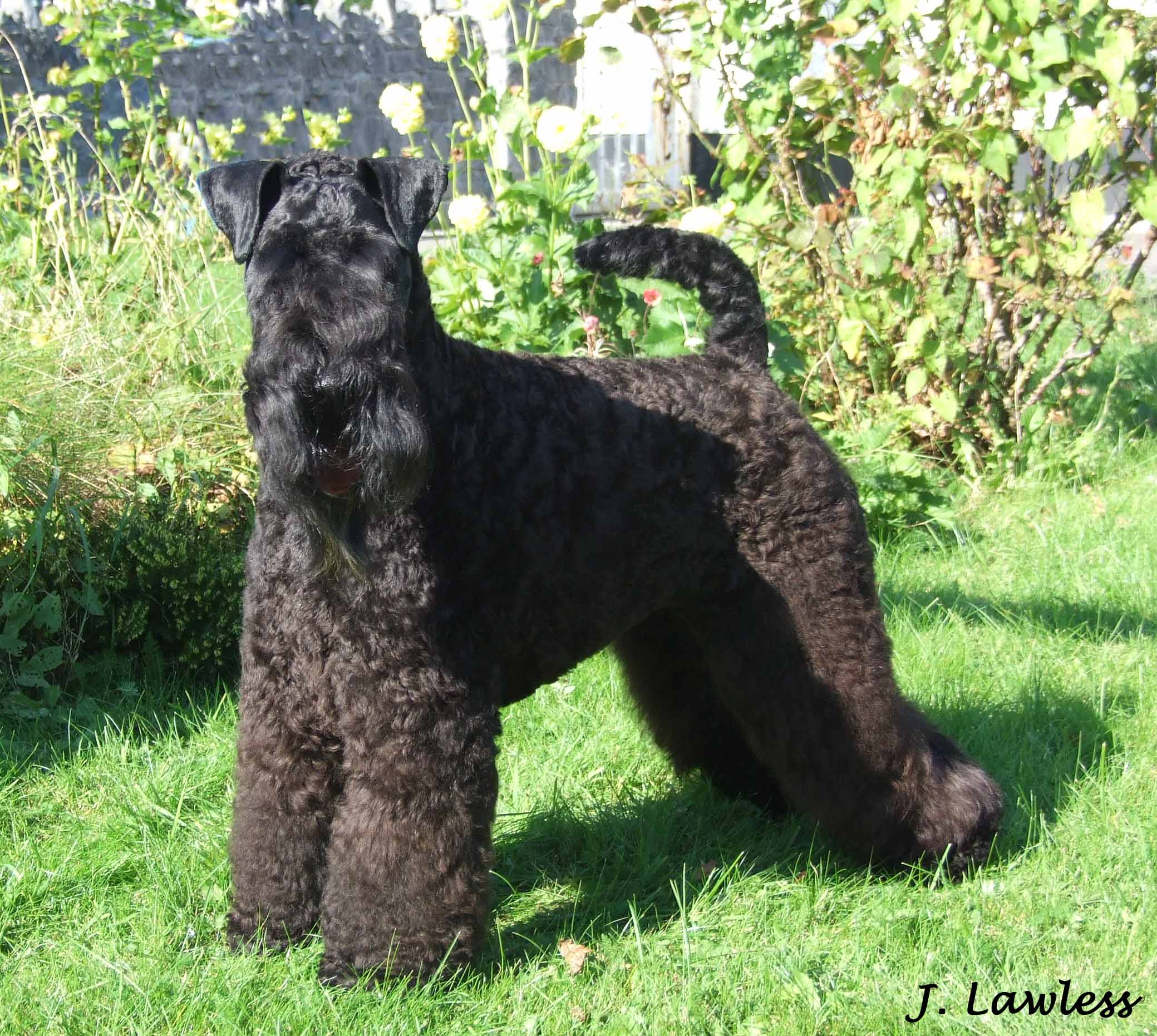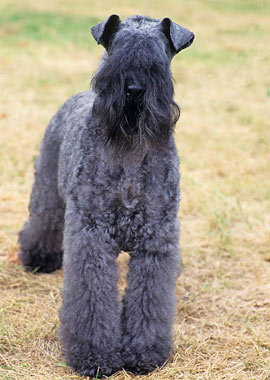
The Breed History
In counties Kerry, Tipperary, and elsewhere in Ireland the breed was
selected as an all-round utility dog for the farm. It is reported that
the Soft-coated Wheaten terrier, perhaps the Irish Wolfhound, and
Bedlington and Welsh terriers contributed to breed development.
Much of the breed development occurred in the 1800s. The breed
standard was written in 1922. First exports to the USA occurred in
1918. The AKC first recognized the breed in 1924.
Breeding for Function
Some of the tasks the Kerry Blue excelled at included dry and wet
retrieving, small game hunting, birddog, and sheep and cattle
herding. Watchdog, companion, and police work round out his
many modern accomplishments.
Physical Characteristics
Height at Withers: female 17.5-19" (44.5-48 cm), male 18-19.5"
(45.5-49.5 cm)
Weight: 33-40 lb (15-18 kg)
Coat: The coat is dense and hairs are wavy and soft in texture. It
takes about 1 1/2 years for the adult coat to mature. Puppies are
often black and during early maturity, very dark gray and brownish
hair may intermingle in the coat until they are gradually replaced
by the correct final hair color of blue (this correct color varies from
light gray-blue to deep slate gray). Extremities may keep a darker
color. Black adults are not accepted.
Longevity: 14+ years
Points of Conformation: This breed is characterized by a sturdy
conformation with lots of muscle and bone, and small dark eyes
somewhat deep set, triangular ears that are small with moderately
thick leather and folded forward. The ear fold is above the topline
of the skull. The skull is flat with a very minimal stop. The nose is
black. The neck is moderately long and strong, not throaty. The
topline is short and level, and there is a slight abdominal tuck. The
tail is high set, and carried high. The thorax is deep and somewhat
narrow, metatarsals and metacarpals are short and sturdy. Feet are
compact, small, and with deep strong footpads with black toenails.
Rear dewclaws disqualify. Gait is smooth, true, elastic and ground
covering with good rear drive.
Recognized Behavior Issues and Traits
Reported breed attributes include: They are considered to be good
guard dogs. Kerry Blues get along with children well and tolerate
play. They commonly exhibit inter-male aggression. They require an
early introduction to and supervision with cats or other small pets.
They have a low barking tendency, are diggers, and need regular
exercise and stimulating games. Intelligent, but easily bored, they
have an independent streak and can be stubborn. They need close
human contact, and do not do well as kenneled dogs. The Kerry Blue
does not tolerate hot weather well.
Normal Physiologic Variations
No undercoat, a no-shedding dog, though care of the coat should
be done regularly to keep it tidy. Considered a high grooming needs
dog. Reportedly no doggy odor even when wet.
Drug Sensitivities
None reported
Inherited Diseases
Hip Dysplasia and Legg-Calve Perthes Disease: Polygenically
inherited traits causing degenerative hip joint disease and arthritis.
OFA reports 5.9% affected.
Elbow Dysplasia: Polygenically inherited trait causing elbow
arthritis. OFA reports 5.0% affected.
Patella Luxation: Polygenically inherited laxity of patellar ligaments,
causing luxation, lameness, and later degenerative joint disease.
Treat surgically if causing clinical signs. Too few Kerry Blue Terriers
have been screened by OFA to determine an accurate frequency.
von Willebrand's Disease Type 1 (vWD): Autosomal recessive
genetic disorder causing a mild bleeding syndrome, usually after
trauma or surgery. A genetic test is available.
Progressive Neuronal Abiotrophy (PNA, Multiple System
Degeneration): Fatal, autosomal recessive cerebellar disorder, with
an onset between 9 and 16 weeks of age. Progresses to incapacity
by 4-8 months of age. Histopathology shows progressive loss
of cerebellar cortical Purkinje's cells, with bilateral symmetric
degeneration of the olivary nuclei followed by degeneration of the
substantia nigra and caudate nucleus. No genetic test is available.
Factor XI Deficiency: Rare, autosomal recessive bleeding disorder
causing a tendency for mild posttraumatic or postoperative
bleeding. Clotting tests show a prolonged activated partial
thromboplastin and activated clotting times. Treat with fresh-frozen
plasma. A genetic test is available.
Disease Predispositions
Sebaceous Cysts: Benign follicular skin cysts. Reported at a
frequency of 22.7% in the KBTF Health Survey 2004. Unknown
mode of inheritance.
Spiculosis (Hard Hairs, Spikes): Hard keratinized hairs produced
by abnormal hair follicles. Reported at a frequency of 6.7% in the
KBTF Health Survey 2004. Unknown mode of inheritance.
Cataracts: Anterior cortex punctate and posterior suture
intermediate cataracts predominate in the breed. Reported at
a frequency of 4.7% in the KBTF Health Survey 2004. Identified
in 3.52% of Kerry Blue Terriers CERF examined by veterinary
ophthalmologists between 2000-2005. CERF does not recommend
breeding any Kerry Blue Terrier with a cataract.
Keratoconjunctivitis Sicca (KCS, Dry Eye): Inadequate tear
production causing drying of the cornea and conjunctiva. Reported
at a frequency of 3.4% in the KBTF Health Survey 2004.
Premolar Hypodontia: Multiple missing premolar syndromes
are reported in the breed. The absence of the second premolars
appears to be an autosomal recessive disorder, while missing fourth
premolars appears to have a more complex, polygenic mode of
inheritance. Studies show that Kerry Blue Terriers with missing
teeth have smaller litter sizes (ave. 3.64 versus 5.72) suggesting a
pleiotrophic effect. Missing teeth are reported at a frequency of
3.3% in the KBTF Health Survey 2004.
Food Allergy (Food Hypersensitivity/Food Intolerance): Presents
with pruritis and pyotraumatic dermatitis (hot spots). Average age
of onset of 1.7 years. Reported at a frequency of 3.3% in the KBTF
Health Survey 2004.
Hypothyroidism: Inherited autoimmune thyroiditis. 2.6% positive
for thyroid autoantibodies based on testing at Michigan State
University. (Ave. for all breeds is 7.5%).
Colitis/Chronic Large Bowel Diarrhea: Onset usually prior to 3
years of age. Reported at a frequency of 2.7% in the KBTF Health
Survey 2004.
Degenerative Myelopathy (DM): Affected dogs show an insidious
onset of upper motor neuron (UMN) paraparesis at an average
age of 11.4 years. The disease eventually progresses to severe
tetraparesis with lower motor neuron signs. Affected dogs have
normal results on myelography, MRI, and CSF analysis. Necropsy
confirms the condition. Unknown mode of inheritance. A direct
genetic test for an autosomal recessive DM susceptibility gene is
available. All affected dogs are homozygous for the gene, however,
only a small percentage of homozygous dogs develop DM. OFA
reports DM susceptibility gene frequencies of 44% carrier, and 12%
homozygous "at-risk". Clinical DM is reported at a frequency of
2.18% in the KBTC Health Survey 2004.
Persistent Pupillary Membranes: Strands of fetal remnant
connecting; iris to iris, cornea, lens, or involving sheets of tissue.
The later three forms can impair vision, and dogs affected with
these forms should not be bred. Identified in 1.76% of Kerry Blue
Terriers CERF examined by veterinary ophthalmologists between
2000-2005.
Distichiasis: Abnormally placed eyelashes that irritate the cornea
and conjunctiva. Can cause secondary corneal ulceration. Identified
in 1.32% of Kerry Blue Terriers CERF examined by veterinary
ophthalmologists between 2000-2005.
Vitreous Degeneration: A liquefaction of the vitreous gel which
may predispose to retinal detachment and/or glaucoma. Identified
in 1.32% of Kerry Blue Terriers CERF examined by veterinary
ophthalmologists between 2000-2005.
Craniomandibular Osteopathy, Dermoid Sinus, Entropion, Patent
Ductus Arteriosus, Progressive Retinal Atrophy, and XX Sex
Reversal are reported.
Isolated Case Studies
Congenital Intestinal Atresia: Case report of a Kerry Blue Terrier
with an undeveloped intestinal tract.
Genetic Tests
Tests of Genotype: Direct gene test for vWD is available from VetGen.
Direct test for an autosomal recessive DM susceptibility gene is
available from OFA.
Direct gene test for Factor XI deficiency is available from PennGen.
Tests of Phenotype: CHIC certification: Required testing
includes hip radiographs and CERF eye examination. Optional
testing includes direct tests for von Willebrands disease, Factor XI
deficiency, and the susceptibility gene for DM. Recommend thyroid profile including autoantibodies, elbow
radiographs, patella evaluation, and cardiac examination.
Miscellaneous
- Breed name synonyms: Kerry Blue, Irish Blue Terrier
- Registries: AKC, UKC, CKC, KCGB (Kennel Club of Great Britain),
ANKC (Australian National Kennel Club)
- AKC rank (year 2008): 120 (274 dogs registered)
- Internet resources: United States Kerry Blue Terrier Club:
www.uskbtc.com
The Kerry Blue Terrier Club of Canada: www.kbtcc.ca
Photo Gallery of Breed - Kerry Blue Terrier - Dog Breed








 Animalia Life
Animalia Life